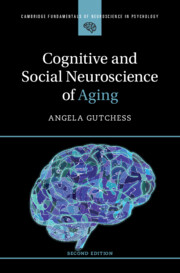Book contents
- Cognitive and Social Neuroscience of Aging
- Cambridge Fundamentals of Neuroscience in Psychology
- Cognitive and Social Neuroscience of Aging
- Copyright page
- Contents
- Figures
- Preface
- Acknowledgments
- Chapter One Introduction to the Cognitive Neuroscience of Aging
- Chapter Two Brain Mechanisms of Aging
- Chapter Three Cognition and Aging
- Chapter Four Memory and Aging
- Chapter Five Emotion, Decision Making, and Aging
- Chapter Six Social Cognition and Aging
- Chapter Seven Alzheimer’s Disease and Other Disorders with Age
- Chapter Eight Current and Future Directions
- References
- Index
- References
Chapter One - Introduction to the Cognitive Neuroscience of Aging
Published online by Cambridge University Press: 14 February 2025
- Cognitive and Social Neuroscience of Aging
- Cambridge Fundamentals of Neuroscience in Psychology
- Cognitive and Social Neuroscience of Aging
- Copyright page
- Contents
- Figures
- Preface
- Acknowledgments
- Chapter One Introduction to the Cognitive Neuroscience of Aging
- Chapter Two Brain Mechanisms of Aging
- Chapter Three Cognition and Aging
- Chapter Four Memory and Aging
- Chapter Five Emotion, Decision Making, and Aging
- Chapter Six Social Cognition and Aging
- Chapter Seven Alzheimer’s Disease and Other Disorders with Age
- Chapter Eight Current and Future Directions
- References
- Index
- References
Summary
This chapter reviews theories of cognitive aging, considering how those classic theories intersect with those informed by cognitive neuroscience methods. The chapter also reviews cognitive neuroscience methods, reviewing methods to study the structural integrity of the brain as well as those used to investigate brain function or the ways in which multiple measures can be combined. The chapter ends with discussion of recent methodological advances, including multivariate analysis methods and the study of beta-amyloid and tau.
Keywords
- Type
- Chapter
- Information
- Cognitive and Social Neuroscience of Aging , pp. 1 - 22Publisher: Cambridge University PressPrint publication year: 2025

